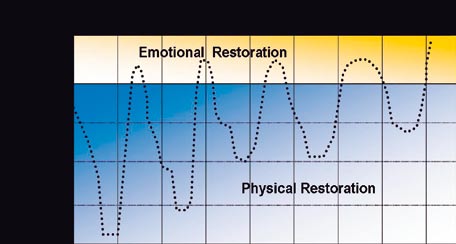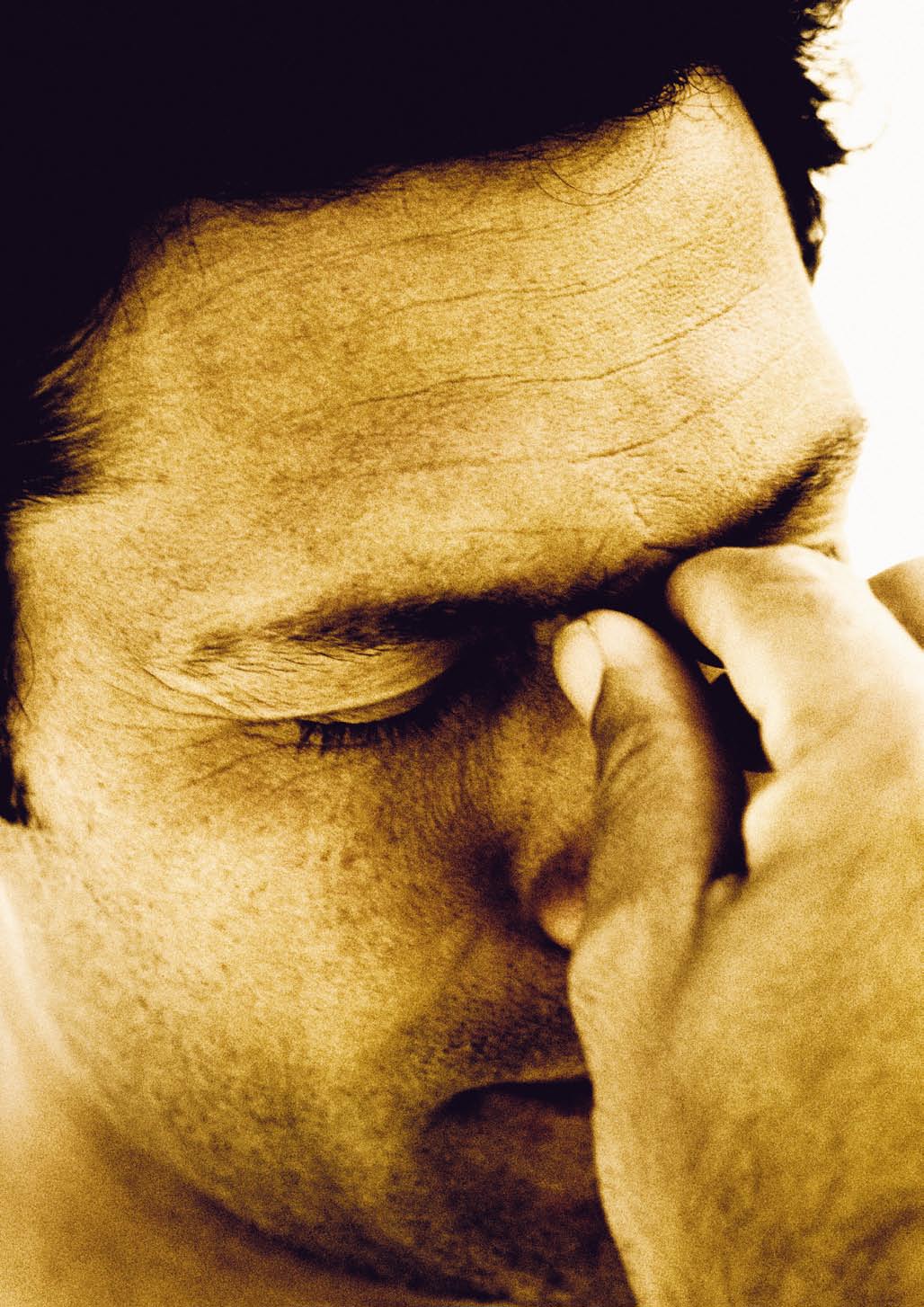Ecophon.ua

Care about sound™
The sound environment in healthcare facilities
Care about sound™
How design affeCts wellbeing
The architectural and functional design of hospitals can improve people's wellbeing. Hospital design must ensure patient services can be provided by staff. In the long-term, it can also promote patient safety and care quality, reduce care costs, lower operating and construction costs as well as provide other significant business advantages.
Nowadays there is growing awareness amongst healthcare managers and architects about the importance of design in a healing environment. The environment should help staff perform to the absolute best of their ability and help patients cope with the considerable stress that illness involves. Supportive Healthcare Design is inevitably holistic and evidence-based: more than 700 research projects have analysed the effects of colour, lighting, temperature and sound on the wellbeing of patients, visitors and healthcare staff. Several investigations and research projects have pointed out clear links between sound levels and the quality of care.
Care about sound
When people think of a place to recuperate from illness or medical treatment, most visualize places that are quiet and peaceful. This is in stark contrast to the typical modern hospital, where noise from beepers, alarms, equipment, telephones, voices and more fill the normal sound environment. Hospital noise - one of the biggest complaints of patients - should no longer be ignored. Especially as a good sound environment becomes indispensable in the context of intense, accurate communication while applying stricter rules regarding patient privacy and patient data security.
Ecophon's system solutions are developed to combine acoustic, aesthetic, hygienic and other relevant requirements. The available solutions are not only decisive for the economics of a healthcare facility but also for recovery and personal health.

"good design can reduce anxiety,
lower blood pressure, improve the
post-operative course, reduce the need
for pain medication and shorten the
hospital stay."
Roger S. Ulrich, Professor
Center for Health Systems and Design Texas A&M
Patient benefits
less sleep deprivation, disturbance and annoyance
reduced need for pain medication
lowered readmission rates
improved healing, thereby reducing stays in hospital
improved patient satisfaction with services provided
decrease in stress, leading to reduced levels of burnout and depression
Can decrease number of medical errors by improved speech intelligibility
Prevents hearing loss for some medical professionals
improved team-spirit and work-satisfaction
Care about sound™
Hospital noise is not only a primary cause of patient dissatisfaction at most hospitals. It can negatively impact patient outcomes, cause sleep deprivation and prolong the healing process.
risk to Patient outComes
Much research has documented the negative effects of hospital noise on patient outcomes. Several studies on infants in natal intensive care units, for instance, show that higher noise levels increase the need for oxygen support therapy, elevate blood pressure, increase heart and respiration rate, as well as negatively affect sleep1-3.
Patients exposed to continuous extraneous noise can also experience
memory alteration, increased agitation, less pain tolerance and feelings of isolation. Noise has been shown to contribute to patient falls, cause confusion and result in increased medication and use of restraint. These environmentally generated symptoms are often medicated or
otherwise treated in ways unrelated to their cause. In addition, hospital noise increases a patient's anxiety and decreases his confidence in the clinical competence of the staff, thus bringing into question the service
HosPital noise:
levels provided. Furthermore, reducing noise has been associated with imroved healing and lowered readmission rates4.
tHe risks
main Cause of sleeP dePrivation
for Patients
Hospital noise is a stress factor that can cause sleep deprivation among patients. Research on adults and children clearly shows that noise is a major cause of waking and of sleep deprivation. When a person is deprived of sleep, there is a risk that this may be associated with a diminished protein synthesis and immune function, both important aspects of healing5.
What causes disturbance to patients' sleep? According to a Finnish
study that sought to clarify the sleep disturbance factors of patients, the cause is the hospital environment itself. Data from 177 patients at the Central Hospital of Northern Carelia's two medical and two surgical wards was collected. The results indicated that hospital environment factors (noise from other patients, equipment, working nurses, and general hospital noise) were regarded as the main causes of sleep disturbance. In fact, 80% of patients regarded these factors as the cause of disturbed sleep. As a comparison, only about half of these patients
the cost of readmitting a
reported that pain disturbed their sleep. Furthermore, it is generally
cardiac patient to critical care
accepted that enhancing sleep quality accelerates healing and recovery6.
is very high. Preventing one
or two readmissions would
How noise led to inCreased Pain mediCation
save so much money that
A study by Barbara Blake Minckley at the Sequoia Hospital in
it could pay for most if not
California looked at how noise effects post operative patients7. The head
all the cost of upgrading the
nurse at the post surgery recovery department, she suspected high noise
acoustic ceilings throughout the
levels could be associated with increased perception of pain amongst
patients returning from surgery. A higher level of activation caused by an environmental stressor (e.g. noise) can make it more difficult to cope
Roger S. Ulrich, Professor
with pain. Her study showed that increased perception of pain caused by
Center for Health Systems and Design
noise led to increased administration of pain medication.
Texas A&M University



Case: sound sleeP witH eCoPHon
Studies conducted by sleep researcher and medical doctor Sören Berg of the University of Lund (Sweden) confirm that
patients' sleep quality is improved when Ecophon sound-
absorbing ceilings are used in the wards8.
Dr. Berg's findings confirm that the sound-absorbing
properties of a room affects a patient's ability to maintain satisfactory sleep quality even when subjected to noise. In
one study, 12 healthy people slept several nights in a ward
in which the ceiling tiles were altered beetween those with
sound-absorbing properties and others with sound-reflecting properties. Various environmental sounds were played
The number of sound-induced instances of waking dropped from
during the night. Objective sleep quality was assessed by
42% to 25% when the ceiling was
electroencephalograph (EEG). When the sound-absorbing
changed from a reflective ceiling
ceiling was in place, the environmental sounds caused less
to an Ecophon Absorption Class A ceiling.The research carried out by
disruption to sleep. Dr Berg's study suggests that equipping a
Dr. Berg was peer-reviewed and
room with an Ecophon sound-absorbing ceiling, resulting in
published in the leading medical
a short reverberation time, makes it possible to remove noise
journal Sleep.
and promote good sleep quality.
references
1. Johnson, A. N.; Neonatal response to control of noise inside the incubator. Pediatric Nursing. (27(6), 600-605; (2001)
2. Slevin, M., et al.; Altering the NICU and measuring infants' responses. Acta Paediatrica. 89(5), 577-581 (2000)
3. Zahr, L. K., & de Traversay, J.; Premature infant responses to noise reduction by earmuffs: Effects on behavioral and physiologic measures. Journal of Perinatology.
15(6), 448-455; (1995)4. Cmiel, C. et al.; Noise Control: A Nursing Team's Approach to Sleep Promotion: Respecting the silence creates a healthier environment for your patients.
American Journal of Nursing. 104(2): 40-48, (Feb, 2004)5. Topf, M. PhD RN; Hospital noise pollution: an environmental stress model to guide research and clinical interventions. Journal of Advanced Nursing.Volume 31, Issue 3; (1996)6. Dogan, O, Ertekin, S, & Dogan, S.; Sleep quality in hospitalized patients. Journal of Clinical Nursing. 14(1):107-13. (Jan. 2005)7. Minckley, BB., A study of noise and its relationship to patient discomfort in the recovery room. Nursing Research. 17(3):247-50. (May-Jun1968)8. Berg, S.; Impact of reduced reverberation time on sound-induced arousals during sleep. Sleep. 24(3):289-92. (May 2001)
Care about sound™
Not only is healthcare a physically and emotionally demanding service to deliver. Healthcare staff and hospital employees spend more time in the facilities than patients do. Healthcare design can help increase employee satisfaction and commitment. After all, the design of a healthcare facility tells a story about that premise and communicates a great deal about management's concern for caregivers.
stress, burnout and turnover
There is evidence that hospital employees perceive high levels of sound as stress-inducing1-3.
One such study, for instance, looked at the correlation between
stress among registered nurses and hospital noise in a tertiary care paediatric intensive care unit. Eleven nurse volunteers took part in the study and were observed for a three-hour period of patient care. Heart rate and sound level were recorded continuously; saliva samples and
stress/annoyance ratings were collected every 30 minutes. Variables assessed as potential confounders were the number of years of nursing experience, caffeine intake, patients' paediatric risk of mortality
HosPital noise:
score, shift assignment, and room assignment. The average daytime sound level was 61 dB, night time 59 dB. Higher average sound
Care for your
levels significantly predicted higher heart rates. Higher average sound levels were also predictive of greater subjective stress and annoyance.
Accordingly, the study reports that noise was shown to correlate with several measures of stress including tachycardia and annoyance ratings.
Other studies show that people who work long shifts in noisy
environments, day in and day out, report effects from exhaustion to burnout, depression, and irritability expressed at home. Interfering and distracting sounds have been shown to contribute to medical and nursing errors. Importantly, noise-induced stress in nurses correlates with reported emotional exhaustion or burnout4-5.
Note: Whenever dB is mentioned in the text, we refer to dB(A) this is weighted to
"we noticed a huge difference
correspond to the human ear.
once we got the new acoustic
ceilings. noise is prevented
mediCal errors and negative sPeeCH intelligibility
from spreading from the
In a 2002 report entitled Healthcare at the Crossroads: Strategies
source to other parts of the
for Addressing the Evolving Nursing Crisis, the Joint Commission
room. we are now able to
on Accreditation of Healthcare Organizations (JCAHO) found that
hear each other more clearly
physical working conditions are key contributors to staff turnover and burnout. JCAHO is a US-based non-profit organization whose aim
when talking, which helps
is "to continuously improve the safety and quality of care provided
reduce stress. the beeps and
to the public through the provision of healthcare accreditation and
alarms from monitoring devices
related services that support performance improvement in healthcare
have now been lowered to
organizations". They mention noise as a potential risk factor related to
bearable levels. and the noise
medical and nursing errors, stating that the ambient sound environments
from ventilation is no longer a
should not exceed the level that would prohibit clinicians from clearly
understanding each other.
Head Nurse, post-surgery recovery room
Halmstad (Sweden) Hospital

Case: aCoustiC design for HealtH witH eCoPHon sound-absorbing Ceilings
The effects of higher versus lower noise levels on the same
The Ecophon sound-absorbing ceilings resulted in:
group of coronary intensive-care nurses were examined
Staff reported that it was easier to understand and
over a period of months. Lower noise levels were linked
communicate with each other
to a number of positive effects on staff, including reduced perceived work demands, increased social support in the
Relaxed staff meant higher quality care; staff perceived
workplace, improved quality of care for patients and better
the pace as slower and the amount of work as less
speech intelligibility6.
demanding during the day
The ceiling tiles in the unit were periodically and
Staff perceived the atmosphere as being better, with less
without anyone's knowledge, changed from ones with
irritation towards each other
sound-reflecting properties to others with sound-absorbing properties. When the sound-absorbing ceilings were
Patients were less likely to be re-admitted (21% vs 48%)
in place, patients slept better, were less stressed (lower
The need for aftercare was reduced when the acoustic
sympathetic arousal), and reported that nurses gave them
environment was improved
better care. The study was unique in that it was possible to confirm the connection between the experiences
Most seriously ill patients experienced a difference in
and spontaneous reactions of the staff to the acoustic
objective stress levels
Quieter environment improved patient sleep quality and lowered patient stress levels
references
1. Bayo, M. V., Garcia, A. M.,Garcia, A., Noise levels in an urban hospital and workers' subjective responses. Archives of Environmental Health. 50(3), 247-251; (1995)
2. Norbeck, J. S., Perceived job stress, job satisfaction, and psychological symptoms in critical care nursing. Research in Nursing & Health. 8(3), 253-259; (1985)
3. Morrison, WE. MD et al., Noise, stress, and annoyance in a pediatric intensive care unit. Critical Care Medicine. 31(1):113-119, (January 2003)
4. Penney, P. J.,Earl, C. E., Occupational noise and effects on blood pressure: Exploring the relationship of hypertension and noise exposure in workers. AAOHN Journal. 52(11),
476-80. (2004)5. Topf, M.,Dillon, E., Noise-induced stress as a predictor of burnout in critical care nurses. Heart & Lung. 17(5), 567-574; (1988)6. Blomkvist, V. et al. Acoustics and psychosocial environment in coronary intensive care. Occupational and Environmental Medicine. (in press).
Care about sound™
According to researchers at Johns Hopkins, noise levels in hospitals throughout the world have been increasing by about 0.4 decibels per year since 1960. Their findings indicate that average daytime hospital sound levels on a global basis have risen from 57 to 72 dB since 1960 and that hospital noise at night has gone up from 42 decibels to 60 dBs. According to the report from Johns Hopkins, current sound levels are now sufficiently high to be a concern to patient safety.
about tHe study
The sound pressure levels in various units of the Johns Hopkins Hospital were monitored using a precision sound level meter, producing sound levels as a function of location, time of day and frequency. Other highlights from the study include:
• The measurements vary little between different types of hospitals,
a growing
indicating the problem is widespread,
• Much hospital noise falls into the human speech frequency range,
making oral communication difficult. This can force doctors and nurses to speak louder to be heard, further boosting noise levels,
• Measurements indicated that noise levels remained
high throughout the day and night.
Case: noise reduCtion strategies imPlemented
Initially, two improvements helped to lower noise levels in several patient care areas. Firstly, staff were equipped with hands-free personal communicators and the regularity of overhead paging dropped to about once an hour, from once every five minutes. Secondly, as many areas lacked sound-absorbing ceiling tiles, researchers wrapped fibreglass insulation inside anti-bacterial fabric and mounted the sound-absorbers onto ceilings and walls in an oncology unit. This reduced sound reverberation by a factor of almost three. After a number of weeks, the researchers' own sound-absorbers were replaced with solutions from Ecophon.
"unnecessary noise is the most
cruel absence of care which can
be inflicted upon either the sick
or well."
Florence Nightingale, 1859

wHat tHe wHo says
The World Health Organization (WHO) guideline values for
continuous background noise in hospital wards are 35 dB,
with night time peaks not to exceed 40 dB. However, many
studies have shown that background noise levels in hospitals
are much higher. Background noise levels are typically 45 dB
to 68 dB, with peaks frequently exceeding 85 dB to 90 dB.1-7
references
1. Aaron, J. N., et al., Environmental noise as a cause of sleep disruption in an intermediate respiratory care unit. Sleep. 19(9), 707-710. (1996)
2. Allaouchiche, B., et al., Noise in the postanaesthesia care unit. British Journal of Anaesthesia. 88(3), 369-373; (2002).
3. Blomkvist, V., et al., Acoustics and psychosocial environment in coronary intensive care. Occupational and Environmental Medicine. (in press)
4. Falk, S. A., & Woods, N. F., Hospital noise: Levels and potential health hazards. New England Journal of Medicine. 289(15), 774-781. (1973).
5. Hilton, B. A., Noise in acute patient care areas. Research in Nursing & Health. 8(3), 283-291. (1985)
6. McLaughlin, A., et al., Noise levels in a cardiac surgical intensive care unit: A preliminary study conducted in secret. Intensive Critical Care Nursing. 12(4), 226-230. (1996)
7. Robertson, A., Cooper-Peel, C., & Vos, P., Peak noise distribution in the neonatal intensive care nursery. Journal of Perinatology. 18(5), 361-364. (1998)
Care about sound™
The sound environment of modern hospitals typically contains very high noise levels, for example:
• Noise from alarms and certain equipment exceed 90 dB, which
is comparable to walking next to a busy street when a large lorry passes. A study in a NICU measured peak levels once per minute and found that 31 percent of peaks exceed 90 dB1.
• Noise peaks in hospitals can be extraordinarily loud. A
recent study recorded 113 dB during shift changes at a large hospital,which is painful and can even be harmful. This can be comparedto a sports event2.
• Noises from surgical drills, saws and other equipment in the
operating theatre are in the range of 100 dB to 110 dB(comparable to a lawnmower) and presents a significant risk for noise-induced hearing loss3-5.
Note: In judging these levels, it is worth noting that the decibel scale is logarithmic; each
10 dB increase represents approximately a doubling of the perceived sound level. A 60 dB sound, accordingly, is perceived as roughly four times as loud as a 40 dB sound.
reasons for tHe noise
A research team from The Center for Health Design recently looked at more than 130 references focusing on noise in hospitals in the published
tHe noise gets
studies. They suggest two general reasons why hospitals are excessively noisy6. First, the noise sources are numerous and they are loud. Second, the surfaces in hospitals (floors, walls and ceilings) are usually hard and reflect sound rather than absorb it. The design of many modern hospitals thus actually amplifies noise. For hygienic reasons, hospitals are built with hard, easy-to-clean surfaces. No carpets or sound-muffling panels are used. These hard surfaces affect sound as a mirror affects light. They simply reflect the sound. If sound is free to bounce around, it will do just that.
sPeaking above tHe noise
A large proportion of hospital noise falls within the frequency range for human speech. Hospital staff often need to express themselves loudly to compete with the background noise from medical equipment, paging systems, mechanical building elements, etc, in order to make themselves heard. Due to this, the sound level inceases even more; this is referred to as the Lombard Effect.
"there's no doubt: you cannot
1. Robertson, A., Cooper-Peel, C., & Vos, P., Peak noise distribution in the neonatal intensive care
nursery. Journal of Perinatology. 18(5), 361-364. (1998)
heal people with buildings and
2. Cmiel, C. et al., Noise Control: A Nursing Team's Approach to Sleep Promotion: Respecting
the silence creates a healthier environment for your patients. American Journal of Nursing.
environments. if you want to
104(2): 40-48, (Feb, 2004)3. Hodge, B., & Thompson, J. F., Noise pollution in the operating theatre. Lancet.
heal people, ask a doctor. but
at the same time no one would
4. Love, H., Noise exposure in the orthopaedic operating theatre: A significant health hazard.
ANZ Journal of Surgery. 73(10), 836-838. (2003)
deny: when we don't make good
5. Nott, M. R., & West, P. D., Orthopaedic theatre noise: A potential hazard to patients.
Anaesthesia. 58(8), 784-787. (2003)
buildings, people suffer!"
6. Ulrich, R., & Zimring, C., et al., The Role of the Physical Environment in the Hospital of the
21st Century: A Once-in-a-Lifetime Opportunity. Report to The Center for Health Design for the
Designing the 21st Century Hospital Project. (Sep. 2004)
Wytze Patijn, architect and former Chief
Government Architect of the Netherlands

Care about sound™
Leaving the sound environment to chance means that patient outcomes are put at risk. In addition, though unintentional, hospital noise sends a signal from hospital management indicating a lack of care towards
patients and caregivers. How can this be improved?
solving HosPital
sound environment assessment
To reduce hospital noise and improve the sound environment, standards
have to be set that are just as stringent as all others relating to patient safety. An assessment of the sound environment provides the basis for this. Many facility areas are dynamic, having peak periods of activity and noise. It is therefore important to profile the facility and list its different sound and functional zones. Identification of noise sources is another important aspect of managing the sound environment. However, many noise sources are not easy to resolve, such as mechanical and building noise. Defining the desired sound environment in a sound policy as well as involving acoustical engineers, architects and building experts is the best way of addressing the planning of renovations as well as the design of new facilities.
ensuring quality sound environments
In its key recommendations for reducing hospital noise1, the Center for Health Design states that environmental interventions that have proven particularly effective for reducing noise and improving acoustics in hospital settings include:
• Installation of high-performance, sound-absorbing ceiling tiles • Elimination or reduction of noise sources (for example, adopting a
noise-free paging system)
the right acoustic ceiling
• Provision of single-bed rather than multibedrooms
reduces noise by several
decibels. the sound-absorbing
The organizational culture of the healthcare facility is of utmost
ability of sound absorbers and
importance in ensuring a high quality sound environment. In general,
acoustic ceilings has a decisive
however, studies of the effectiveness of noise-reduction measures
significance for sound levels in
suggest that environmental or design interventions are more successful
than organizational interventions, such as staff education or the introduction of quiet hours.2-4
Researcher in engineering acoustics
sound environment Planning: some tiPs
reduction of equipment noise: Alarms, signals, pumps, beepers,
telephones, televisions, radios: the equipment used to facilitate healthcare
work is procured in separate processes, with acoustic performance often
being neglected in the brief.Ensure that equipment sound is taken into
consideration and that it can be controlled.
layout and zoning: The use of distance and layout to separate loud and
quiet activities is an effective way of reducing disturbance. A well-planned,
logistic flow of supplies and people reduces the noise level, allowing patients
to rest and staff to focus on the tasks at hand.
room acoustics: In rooms with hard surfaces, sounds build up and
increase the general noise level. The use of sound-absorbing material reduces
noise levels and increases comfort. In larger rooms, the amount of sound
absorption will also affect sound propagation in the room and from the room
to other areas as well as vice versa.
references
1. Ulrich, R., & Zimring, C., et al., The Role of the Physical Environment in the Hospital
of the 21st Century: A Once-in-a-Lifetime Opportunity. Report to The Center for Health
Design for the Designing the 21st Century Hospital Project. (Sep. 2004)2. Gast, P. L., & Baker, C. F., The CCU patient: Anxiety and annoyance to noise. Critical
Care Nursing Quarterly. 12(3), 39-54. (1989)3. Moore, M. M. N., et al., Interventions to reduce decibel levels on patient care units.
American Surgeon. 64(9), 894. (1998)4. Walder, B., et al., Effects of guidelines implementation in a surgical intensive care unit
to control nighttime light and noise levels. Critical Care Medicine. 28(7), 2242-2247.
Care about sound™
The quantity and placement of sound-absorbing material is the key factor for good room acoustics in healthcare facilities. Room acoustics relate to the sound environment in a restricted space. The most common measurement is reverberation time, but in many instances it is of even greater importance to measure the reduction in sound level. In rooms where transmission and communication of information is of great importance, other measurements can be used to gauge speech intelligibility or privacy.
sPeeCH PrivaCy
Speech privacy is of increasing importance in everyday life, including
healthcare facilities. The need to measure and rate a room's performance
is driven by both patient demand for the respect of privacy and by
regulations. According to ISO, speech privacy is conversation that is not
intelligible to casual listeners. It is defined by the Articulation Index (AI) and can be measured objectively.
defining
When it comes to minimising sound disturbance between people and/or different areas, room layout is very important. Speech is the most
good room
disturbing factor because it is very difficult to 'tune out' and distracts people more due to the instict to try to hear what is being said. However,
in healthcare premises, individuals must be given as much privacy as possible. In order to prevent sound from being reflected and propagated via the ceiling, it is crucial that the acoustic ceiling has excellent sound absorption properties across the whole frequency range.
baCkground noise level
This is weighted to correspond to the human ear, dB(A). The WHO
recommends that the equivalent sound level should not exceed 35dB in
areas where patients are being treated, observed or resting. Momentary
sound during the night should not exceed 45dB. An effective acoustic
ceiling reduces background noise.
sPeeCH intelligibility
This indicates the extent to which a listener understands what is being
said by the speaker. Various methods are used to quantify speech
intelligibility. Speech intelligibility is directly dependent on the level
of background noise, reverberation time and the shape of the room.
Different methods are used to evaluate speech intelligibility. Effective
acoustic ceilings improve speech intelligibility.
sound Pressure level
High noise levels due to activities or equipment are often the main
disturbance in many surroundings. These make communication difficult
and increase stress and the feeling of discomfort. To decrease the sound
pressure level in an efficient manner it is important to use acoustical
products with as high sound absorbing properties as possible.
reverberation time
This indicates the time needed for a single sound to decrease by an
interval of 60 dB. A short reverberation time is often considered to
provide a more home-like acoustic environment with a lower echo. In
healthcare buildings, room surfaces are often made from hard, sound-
reflecting materials; these have a negative impact on room acoustics.
A short reverberation time can be achieved by using sound-absorbing
ceilings or wall panels.
wHy sound absorbing
materials?
Increases privacy and confidentiality
Reduces sound propagation
Reduces sound levels
Improves communication
Reduces sound reflection and flutter echo
Improves concentration
Increases speech intelligibility
Enhances overall sound quality.
Care about sound™
Every room in a healthcare facility has specific quality requirements regarding building materials and solutions. The number and complexity of requirements increases as the level of care increases. Ceiling and wall solutions can offer other functional properties in addition to sound absorption. Ecophon offers a portfolio of sound-absorbing ceiling and wall solutions that meets all quality requirements while also offering all the functional properties relevant to healthcare facilities. Some of the
major properties are listed on these pages.
different
zones,
different
requirements
Ecophon ceiling systems are classified
A number of Ecophon's sound absorbers
according to EN ISO 116 54, which
are eco-labelled with the Nordic Swan
ranges sound absorption from class A to E.
showing that they fulfil the criteria and
The majority of Ecophon systems meet the
demands of the of the Nordic Eco-labelling
highest class, Class A. The corresponding
council in respect of the product's entire life
NRC/SAA value according to ASTM
cycle, from raw materials to reclamation.
C 423, is between 0.85 and 1.0. The
Demands relate to aspects that include
maximum value that can be achieved is
discharges and emissions that are health
hazards, the handling of waste and the use of energy and natural resources.
Cleanability/disinfeCtion
Ecophon ceiling systems are classified for
Ce marking
different requirements. Smooth, glossy, hard
CE marking is used to allow the free trade
materials are traditionally associated with
of products within the EU. The basic rule
a high level of cleanability and hygiene.
is that it should be possible for a product
On the other hand soft, porous materials
that is CE marked to move across Europe's
are usually needed for efficient sound
internal borders without any national
absorption. Ecophon Hygiene systems
marking requirements or control of what
successfully combine acoustic performance
is covered by the CE marking.This means
with high cleanability. The materials used
that all manufacturers on the European
do not act as a breeding ground for
market must comply with the same
standard, leading to the harmonisation of reporting on different product properties.
This simplifies the comparison of acoustic
Dust and emissions play a part in the
solutions and many other products.
increase in allergies. Ecophon offers products certified by the Indoor Climate
P marking
Labelling (DIM), fulfilling the highest
A P-labelled sound absorber secures that
requirements, and also offers suitable
the absorption stated by the manufacturer
solutions for environments that demand
is fulfilled. Ecophon has chosen to permit
limitation of airborne particles. They are
its sound absorbers to undergo an
also recommended by the Swedish Asthma
objective scrutiny at SP (Sweden's Testing
and Allergy Association.
and Research Institute) regarding sound-absorbing ability in order for them to be
P-labelled. This removes all uncertainty
Ecophon offers ceilings that are able to
about incomplete or "home made"
withstand a permanent ambient RH up to
measurement values.
95% at 30°C without sagging, warping or delaminating. A higher temperature/moisture is permissible during washing.
PubliC zones
The stress associated with having to go to hospital as a patient or
Different types of nursing zones are required depending on the
visitor can be eased by creating an acoustic environment suitable
needs of individual patients. Along with offering nurses with an
for communication and orientation. Large, open areas/spaces
effective work environment, the most important function for a
make sound propagation an issue. Reception areas need to be
nursing zone is to offer the patient an environment that promotes
designed with acoustic privacy and speech intelligibility in mind.
sleep and recovery.
With proper design and use of colors, patients can be eased to find the most logical way to their destination. The performance of
The overall purpose of the nursing zone:
the acoustic ceiling has a significant impact.
• Facilitate supervision, medication and instruction for nurses
examPles: entrance hall, restaurant, corridor, waiting areas
• Ensure patients can rest and sleep
• Act as a place to recover and prepare for everyday life
examPles: wards, patient rooms, consulting rooms
suPPorting zones
CliniCal zones
Throughout a hospital there are many functional areas that
Clinical zones should support effective use of medical equipment.
support the facility's operations. Laundries and kitchens generate
Communication and function are of critical importance.
extra humidity. Others, like laboratories, involve requirements
Technological requirements involve the need for the frequent
for cleaning all surfaces or the need to regularly carry out a total
expansion of these areas. Ceilings should therefore allow
decontamination using strong, disinfectant chemicals. Supporting
flexibility, accessibility as well as durability. The clinical zone
areas also encompass in-house support functions, such as public
is the fastest growing area in the hospital. The cost of modern
and private businesses and hospital administration. Research in
medical equipment makes it necessary to consolidate with central
office environments confirms the positive impact low sound levels
facilities for effective use.
have on performance.
The overall purpose of the clinical zone:
examPles: laboratory, laundry, kitchen, meeting and
• Diagnostics and treatment
conference rooms, lecture rooms
• To communicate and give instructions in sensitive matters
• To interpret and analyse medical data
examPles: operating theatre, pharmacy
Saint-Gobain Ecophon AB, Box 500, S-26061 Hyllinge, Sweden
Phone:+46 42 17 99 00, Fax +46 42 22 59 29
e-mail: [email protected],
Source: http://www.ecophon.ua/globalassets/old-structure/05.ecophon.com/care-about-sound.pdf
This article was first published inWise Traditions, the quarterly magazine of The Weston A. Price Foundation,Washington, DC, www.westonaprice.org, (202) 333-HEAL. By Eric Davis, DDS In Greek mythology, Mercury is the Although a natural component of lower-order organisms are eaten by higher- fleet-footed messenger of the Gods. He the earth's crust, mercury does not have a
Yonsei Med J 53(4):842-848, 2012 pISSN: 0513-5796, eISSN: 1976-2437 Fluoxetine Protects against Big Endothelin-1 Induced Anti-Apoptosis by Rescuing Kv1.5 Channels in Human Pulmonary Arterial Smooth Muscle Cel s FeiFeng Dai, ZhiFu Mao, Jun Xia, ShaoPing Zhu, and ZhiYong Wu Department of Cardiothoracic Surgery, Renmin Hospital of Wuhan University, Wuhan, China.











